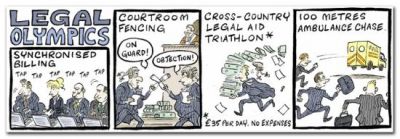Another recent tweet from APIL (on 8 August 2012):
“Prof Löfstedt wrote in his recent report that no evidence has been presented of a compensation culture – it’s a myth, not reality.”
Again, sadly APIL provided no link to this report and it is therefore not entirely clear which one they are referring to. However, from a quick internet search it appears that the report they had in mind is Reclaiming health and safety for all: An independent review of health and safety legislation, Professor Ragnar E Löfstedt, November 2011.
If that is correct, a reference to a November 2011 report is hardly the kind of breaking news one normally expects to see on Twitter.
But, does the report actually reach this conclusion? From a quick glance at the same, the closest the Professor seems to come is the following:
“The ‘compensation culture’ (or the perception of it) in the UK has been the subject of several reviews over the last few years, but no evidence has been presented for its existence. … The evidence does seem to suggest the belief in a compensation culture is still having a significant impact on the behaviour and outlook of business, with the Better Regulation Task Force concluding that, although it is a myth, the perception of its existence, driven by media coverage, has a significant impact on the behaviour of both public and private employers”
What there appears to be is a total failure to undertake any kind of statistical analysis on claims numbers or even to properly define “compensation culture”.
Of course, one person’s “compensation culture” is another person’s “access to justice”.
The fact that the report refers back to the conclusions of the Better Regulation Task Force is revealing. As I have commented before, the Better Regulation Task Force’s conclusion that the compensation culture was a myth was based on the fact the total number of claims between 2000 and 2003 were broadly flat and then went down in 2003/2004. A reasonable conclusion based on the evidence.
Now let’s examine the evidence since then.
The CRU figures for registered RTA claims:
2006/07 – 518,821
2007/08 – 551,905
2008/09 – 625,072
2009/10 – 674,997
2010/11 – 790,999
2011/12 – 828,489
A 59% increase over the period.
CRU figures for clinical negligence:
2006/07 – 8,575
2007-08 – 8,876
2008/09 – 9,880
2009/10 – 10,308
2010/11 – 13,022
2011/12 – 13,517
A 57% increase.
CRU figures for total claims registered:
2006/07 – 710,784
2007/08 – 732,750
2008/09 – 812,348
2009/10 – 861,325
2010/11 – 987,381
2011/12 – 1,041,150
A 46% increase
(The only category to have gone down overall is EL claims and this is almost certainly due to changes in the nature of employment of UK workers and possibly changes to the law concerning asbestos related injuries.)
The claimant lobby can’t have it both ways. If the Better Regulation Task Force was correct to conclude that falling claim numbers was evidence there was no compensation culture, then the recent soaring in claims numbers must be evidence that one now exists.
When the facts change, I change my mind. What do you do?

